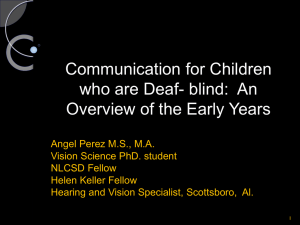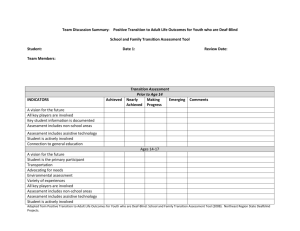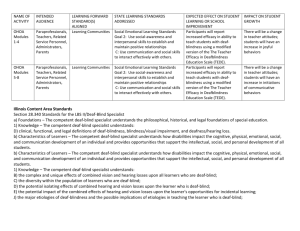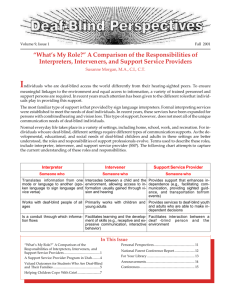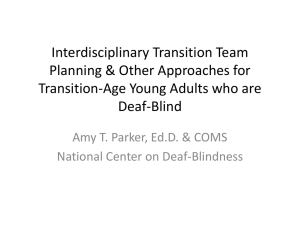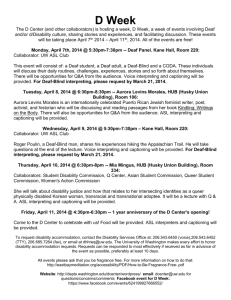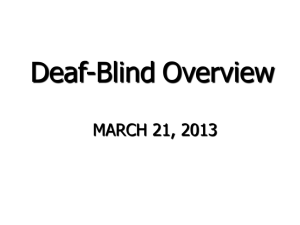Deaf-Blindness and Transition from High School
advertisement
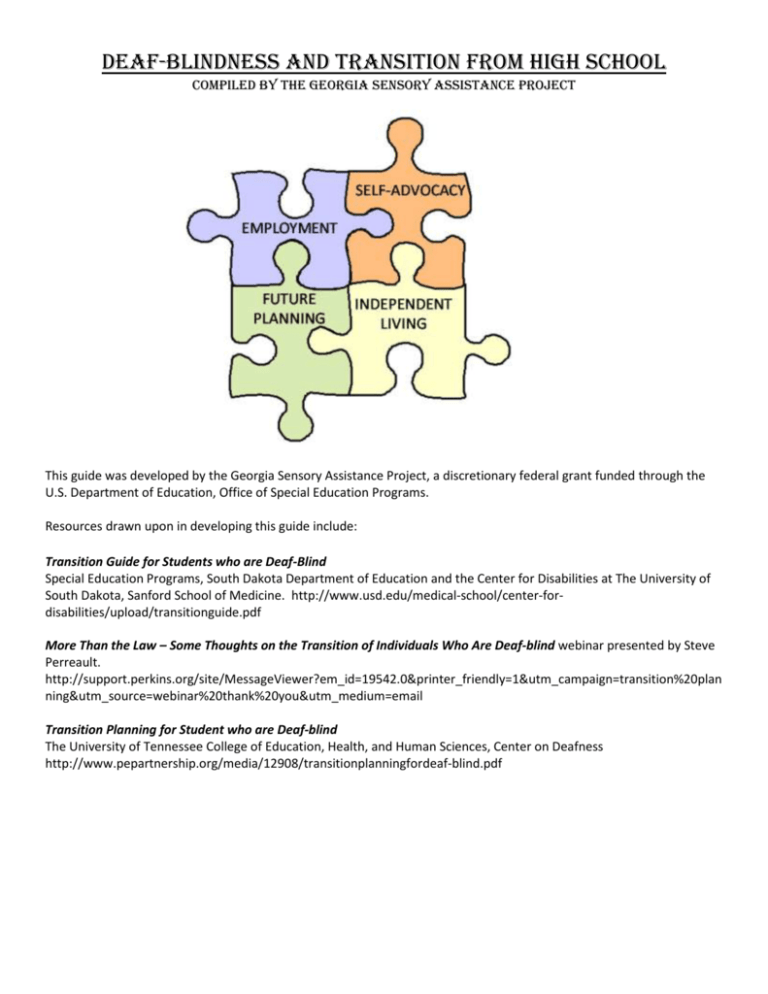
Deaf-blindness and Transition from high school compiled by the Georgia Sensory Assistance Project This guide was developed by the Georgia Sensory Assistance Project, a discretionary federal grant funded through the U.S. Department of Education, Office of Special Education Programs. Resources drawn upon in developing this guide include: Transition Guide for Students who are Deaf-Blind Special Education Programs, South Dakota Department of Education and the Center for Disabilities at The University of South Dakota, Sanford School of Medicine. http://www.usd.edu/medical-school/center-fordisabilities/upload/transitionguide.pdf More Than the Law – Some Thoughts on the Transition of Individuals Who Are Deaf-blind webinar presented by Steve Perreault. http://support.perkins.org/site/MessageViewer?em_id=19542.0&printer_friendly=1&utm_campaign=transition%20plan ning&utm_source=webinar%20thank%20you&utm_medium=email Transition Planning for Student who are Deaf-blind The University of Tennessee College of Education, Health, and Human Sciences, Center on Deafness http://www.pepartnership.org/media/12908/transitionplanningfordeaf-blind.pdf Deaf-Blindness and Transition from High School Transition is a process and a partnership to prepare a student for adult life, while still in school. The student’s Individual Education Plan (IEP) should address the need for training, education, employment, and, where appropriate, independent living skills for the student to achieve success and independence as an adult. When planning transition services for students who are deaf-blind, a team faces challenges unique to this very low incidence population. Who are we talking about when we say “deaf-blind”? Many people think of someone without vision or hearing - like Helen Keller. In reality, the term is used to describe a diverse group of people who have some combination of a vision and hearing loss. Even a mild or moderate loss of one of these senses can create significant challenges when combined with a loss in the other sense. The primary needs of people who are deaf-blind are the ability to access information from their environment and to communicate with others. This can impact all areas of the person’s life, including learning, relationships, recreation, and vocation. There is a wealth of information and resources on both national and state levels for effective transition services and planning for people with disabilities. We hope with this guide to provide some information specific to the unique aspects of transition for a young person who is deaf-blind; specifically addressing Communication, SelfDetermination, Transition Assessment, and Resources for Deaf-Blind. I. Important Components of Transition Planning for Persons Who are Deaf-blind Communication Communication is a major challenge for students who are deaf-blind. Communication skills for people who are deaf-blind can include spoken, written and/or signed formal language but also include using behaviors like crying, and grabbing, facial expressions, gestures and vocalizations to express wants and needs. It is imperative that all forms of communication by a person who is deaf-blind be respected and sought out. It is a crucial job of the transition team to determine for every student with deaf-blindness, a communication system that allows them to communicate to the fullest extent and with the widest community. In school, at home and in the community, persons who are deaf-blind need to be in an environment which encourages both their expressive and receptive communication attempts. This standard should also be used when planning for the future. What settings will provide the richest communication environment? What supports need to be in place to facilitate communication such as interpreters, interveners, Support Service Providers (SSPs) adaptive equipment, etc.? How will others in the environment learn the communication methods used by this person? Some links to information about the unique communication needs of young adults who are deaf-blind include: The American Association of the Deaf-Blind has a factsheet that describes the many communication methods used by adults who are deaf-blind- How Do Deaf-Blind People Communicate? http://www.aadb.org/factsheets/db_communications.html) For students who use sign language to communicate, but have a visual impairment, Susie Morgan has developed a great resource for interpreters who may not be familiar with the accommodations necessary when working with students who are deaf-blind- A GUIDEBOOK FOR INTERPRETERS Making Accommodations for Individuals with Dual Sensory Impairments (http://www.nationaldb.org/ISSelectedTopics.php?topicCatID=19) For non-traditional communicators: o The Communication Matrix (www.communicationmatrix.org) is an assessment that can help a team determine what messages a student is communicating and how they communicate it. The results of this assessment can be shared through an individualized communication dictionary or portfolio. o The New England Center Match Maker Project has put together a guide -Developing Communication Portfolios (http://www.necdbp.org/pubs/MatchMaker%20Manual.pdf) that offers 2 instructions and examples of communication portfolios that can help new people understand the unique communication of a student who is deaf-blind. Check out the Communication Inventory on page 91 of that article. The new National Deaf-Blind Equipment Distribution Program will enable low-income individuals who are deaf-blind to access 21st century communications services. The program in Georgia is called iCanConnect/GA and is being managed by the Georgia Council for the Hearing Impaired (GACHI) and information and applications are available at http://gachi.org/?page_id=561 . Self-Determination Self-determination is the inherent right of people to assume control of and make choices that have an impact on their lives, and is an important part of a successful transition. A self-determined person can identify and pursue goals, take an active part in decision-making, recognize their strengths and challenges and advocate for what they need. Self-determination must be developed through opportunities to exercise choice and decision making. For students who are deaf-blind, access to information is limited and opportunities to make decisions about their lives are often restricted. Many students who are deaf-blind are not aware of the choices and options that are available to them because they cannot look around and see what others are doing, or listen to friends and family talk about their work or leisure activities. Some students do not fully understand their disability and the accommodations they need, and cannot successfully advocate for themselves. Many people see a child who cannot communicate in traditional ways and assume the child is unable to make decisions or even have preferences. Involving students early in their IEPs- thinking about their preferences, strengths and challenges; having them start early to set goals and explore options, and giving them real-life opportunities to make decisions, are important aspects of their transition planning. Some resources on Self-Determination include: Aspire is a project to promote student involvement in their IEP, which builds both self awareness, and self-advocacy skills. ASPIRE flyer http://www.parentmentors.org/Documents/School/ASPIRE_flyer.pdf Check our website for information on the next Transition Institute- GSAP holds an annual Georgia event and a Southeast Regional event designed to build self-determination skills in young adults who are deaflblind. GSAP teen events page http://education.gsu.edu/georgiadeaf-blindproj/teenevents.aspx%20%20 Some great practical tips for building self-determination skills with your children are found in an article by Deborah Sewell from the Texas School for the Blind and Visually Impaired: Becoming Empowered Through Self-Determination Skills http://www.tsbvi.edu/resources/2680-becoming-empoweredthrough-self-determination-skills The website, www. imdetermined.org, has modules on disability awareness, student involvement, and lesson plans on self-determination. GSAP has a copy of a self-determination curriculum developed specifically for teens who are deafblind. Give us a call if you would like to have us go through it with you. Hands-On Community Experiences: Independent Living It is important for young adults who are deaf-blind to be as independent as they can be and take on responsibilities for chores around the house early in life. The National Consortium on Deaf-blindness website has several good resources on involving children in daily living skills from an early age: http://www.nationaldb.org/ISSelectedTopics.php?topicCatID=775 Some students will need support after they leave high school to work on independent living skills. The Helen Keller National Center on Long Island, NY offers a residential comprehensive training program that includes communication, orientation and mobility, assistive technology, independent living, and vocational assessment/training. http://www.hknc.org/VocRehabTraining.htm . They also have a two-week summer 3 program for students age 16 – 22. For more information, contact Barbara Chandler – 516-393-7733 (Voice) or barbara.chandler@hknc.org. In Georgia, the new Cave Springs Rehabilitation Center can provide independent living skills training in a residential model after high school. The center has traditionally served deaf adults, but can provide vision supports and Orientation and Mobility services through a contract with Vision Rehabilitation Services (VRS). For more information, contact Rebecca Cowan-Story - 706-777-2341 (Voice) or Rebecca.cowanstory@gvra.ga.gov. Social Life and Relationships Research has shown that people with disabilities often have reduced opportunities for social networking and participation in community activities. Barriers may include limited communications skills, physical limitations, and/or cognitive impairments. When completing transition planning for these individuals, special attention should be devoted to this area as for many of us it is our relationships that are the most meaningful thing in our lives. People who are deaf-blind should be provided this same opportunity. One way to assist a person who is deaf-blind in making social connections with others is through the use of a third party trained to provide communication assistance. In schools this person is typically called an intervener. For adults this support is supplied by Support Service Providers (SSPs). SSPs can be paid or work as volunteers to help the person communicate, travel and know what is going on around them. They can also serve to provide the person with necessary visual information about the environment and other people. They can share some of the important social cues the person who is deaf-blind may be missing, such as facial expression, body language and vocal inflection. An intervener or SSP is different from an interpreter, who is a trained and certified professional with a strict code of ethics which does not allow for the kinds of services that the intervener/SSP needs to provide. Video and description of the program in Seattle-www.seattledbsc.org/visualweb/services/sspvis.html SSP information page by AADB- http://www.aadb.org/information/ssp/ssp.html SSP training in Georgia is conducted by Georgia Vocational Rehabilitation Agency (GVRA). Rebecca Cowan-Story is the Coordinator for Deaf-blind Services. For more information about SSPs and to see if there are SSPs in you area, contact her at Rebecca Cowan-Story State Coordinator of Deaf Blind Services 706-622-6566 video phone 706-777-2341 phone rebecca.cowan-story@gvra.ga.gov Resources for social activities for students who are deaf-blind: The Georgia DB Association (GADB)- http://www.aadb.org/resources/db_organizations/georgia.html has social events and informational meetings each year. The Georgia Council for the Hearing Impaired (GACHI) – www.gachi.org has organized events and training for the hearing impaired. News about activities in the deaf and deaf-blind community in Georgia is available at Epeachy News http://www.epeachynews.org/ Blind organizations that provide information and social activities in Georgia are the National Federation for the Blind (NFB) http://www.nfbga.org and The Georgia Council for the Blind (BCB) http://www.georgiacounciloftheblind.org/ Employment Employment opportunities are often limited for people who are deaf-blind for a number of reasons. One of the reasons may be that people who are deaf-blind often have limited life experiences that have not allowed them to see and interact with a wide range of jobs. Sighted, hearing children see people working throughout their childhood. As they get older, they have opportunities to “practice” for future employment by doing chores around the house and providing services for others outside their own home such as babysitting, lawn mowing, etc. Many of these incidental and practice experiences are not available for people who are deaf-blind. Starting as early as possible, it is important for a child who is deaf-blind to build a knowledge and experience base 4 regarding employment. This can begin with exposing the child to a variety of community experiences so they have interaction opportunities. As he/she moves into adolescence, providing opportunities for paid employment is a vital component of building that knowledge base. This can be a daunting task, especially in rural areas where jobs for people in general may be hard to find. Another challenge for a person with deaf-blindness in finding employment is a lack of understanding of their own interests and abilities and no sense of their own powers of self-determination. These self-limiting perspectives can be extremely detrimental to transition success and addressing them should begin in childhood. Career Connect at the American Foundation for the Blind, allows students who are blind and visually impaired to explore careers, find mentors, and get tips to finding and keeping a job. http://www.afb.org/section.aspx?FolderID=2&SectionID=7 iTranstition is the website developed by PEPNet –the transition org for students who are deaf or hard of hearing. ITransition helps students create a life plan and learn about work and college. http://itransition.pepnet.org/ Vocational Rehabilitation has a State Coordinator for Deaf-blind Services who should be contacted early in the transition process. Rebecca Cowan-Story State Coordinator of Deaf Blind Services 706-622-6566 video phone 706-777-2341 phone rebecca.cowan-story@gvra.ga.gov The Georgia Department of Behavioral Health and Developmental Disabilities (DBHDD) is the state agency that focuses on policies, programs, and services for people with developmental and intellectual disabilities and administers the NOW and COMP waivers that can provide for supported employment services. http://dbhdd.georgia.gov/developmental-disabilities . You can find your regional office at their website: http://dbhdd.georgia.gov/regions Post-Secondary Education or Training Students who are transitioning from high school to post-secondary education or training should have a good grasp of the accommodations they need to succeed in class. One of the best tools to help students prepare for advocating for their needs in college or training programs is A GUIDE FOR STUDENTS WHO ARE DEAFBLIND CONSIDERING COLLEGE”, developed by the Helen Keller National Center. This document can be accessed via www.HKNC.org under the Publications link, Item number 6. iTransition, a website developed by PepNet for students who are deaf or hard of hearing has an on-line module to help students prepare for what they will experience in college. http://itransition.pepnet.org/ II. Transition Assessment: The Individuals with Disabilities Education Act (IDEA) requires that a student’s Individualized Education Program (IEP) include transition planning by age 16 or earlier, if appropriate. This plan should reflect a student’s interests and preferences, current accomplishments and skills, what they still need to learn, as well as what they want to do in life. This can include a range of goals - everything from the type of career the student would like to pursue to the kind of living situation he or she hopes to have. In addition, students who are deaf-blind benefit from additional assessments as they approach transition related to their vision and hearing loss. Identifying Student Interests and Abilities For many students who are deaf-blind, articulating their interests, preferences, and goals can be difficult. Many schools use computer-based interest inventories or interviews to gather information about student interests and abilities. Some of these programs are not accessible for the students’ media needs, and many require a language and literacy level beyond the student who is deaf-blind. Young people who do not speak, sign or use communication devices can still communicate their preferences and dislikes. There are alternative 5 methods, including Person-Centered Planning, and the Discovery Process from Customized Employment to identify a student’s individual goals, interests and abilities; and to help students, families and professionals craft plans that will support students as they strive to achieve their dreams. Student profiles or portfolios have been developed by that can help a team give their student a voice in the process GSAP can provide TA on both Person-Centered Planning and Discovery. Person Centered Planning is a process of bringing supportive people together to help someone define and achieve a dream for the future. It is a “Person-Centered” way to make community contacts and overcome barriers for a person who has a disability. The emphasis is on strengths instead of limitations. Everyone shares anecdotal information instead of reading reports or interpreting test results. Based on the stories, the person and those who provide support are able to more clearly define a dream for the future and participate in achieving that vision. These dreams can be represented in visual maps reflecting the individual’s past and their future aspirations. Georgia State University’s Center for Leadership in Disability trains facilitators for PersonCentered Planning. Contact: Stacey Ramirez- sramirez@gsu.edu, 404-413-1288 The Discovery Process is taken from the Customized Employment model of job development. In Discovery, instead of starting with what job sites are established already and giving the student vocational assessments to see if they can do a particular job, the goal is to get to know students by spending time with them to learn their interests, preferences, strengths and the tasks they can do. Discovery provides information about a student’s abilities and support needs, so a custom job can be tailored. Georgia has a pilot program with GVRA, Web-based Transition Tools developed for students who are blind or deaf Career Connect at the American Foundation for the Blind, allows students who are blind and visually impaired to explore careers, find mentors, and get tips to finding and keeping a job. http://www.afb.org/section.aspx?FolderID=2&SectionID=7 iTranstition is the website developed by PEPNet –the transition org for students who are deaf or hard of hearing. iTransition helps students create a life plan and learn about work and college. http://itransition.pepnet.org/ Transition planning tools for students with multiple disabilities: The GSAP website has 3 tools that can help families begin transition planning: David Wiley’s 3-Part Planning Tool, A Student Portfolio, and a Transition Checklist (adapted from the South Dakota Transition Guide for Students who are Deaf-Blind).. http://gsap.coe.uga.edu A group of professionals in deaf-blindness have developed a, School and Family Transition Assessment Tool - http://c324175.r75.cf1.rackcdn.com/products/Transition%20Rubric.pdf that allows a team to consider the important components of transition planning for students who are deaf-blind. The Transition Guide for Students who are Deaf-Blind developed by Special Education Programs, South Dakota Department of Education and the Center for Disabilities at The University of South Dakota, Sanford School of Medicine. This is a great resourcehttp://www.usd.edu/medicalschool/center-for-disabilities/upload/transitionguide.pdf Some good information on Person Centered Planning is available at: California deaf-blind services has a booklet that describes the MAPS process and explains the purpose of each map: Planning for the Future of a Student with Visual and Hearing Impairments http://c324175.r75.cf1.rackcdn.com/products/MAPSEnglish.pdf The National Center on Secondary Education and Transition has a Parent Brief on Person-Centered Planning that describes steps to using a person-centered plan as part of transition planning Parent Brief on Person-Centered Planning http://www.ncset.org/publications/viewdesc.asp?id=1431 6 The Minnesota Council on developmental Disabilities has produced a booklet on personal futures planning that is a comprehensive guide to using Person-Centered Futures Planning: It's Never Too Early, It's Never Too Late http://www.mnddc.org/extra/publications/Never_too_Early.PDF Parent to Parent of Georgia has a great page on planning for the future that describes many kinds of person-centered planning - Creating A Life Plan (http://roadmap.p2pga.org/index.php?option=com_content&view=article&id=680&Itemid=143) Information on the Discovery Process Employment First Georgia (www.employmentfirstgeorgia.org) can provide information about customized employment and the discovery process. The University of Montana Rural Institute has developed a Transition Assessment and Planning Guide that uses the Discovery Model. On their website, you can get a copy of the form, and view a sample form: http://ruralinstitute.umt.edu/transition/forms_tools.asp The Rural Institute also has a Discovery Log that lists the 20 Steps to Discovery which you can download: http://ruralinstitute.umt.edu/transition/Discovery.asp Additional Assessments for Students who are Deaf-blind Vision and Hearing Evaluations: Students should have a current eye report, functional vision evaluation, and low vision evaluation as part of their preparation for transition into a new setting. There are some disorders which cause the vision to deteriorate as the student gets older and moving into a different environment may uncover unrecognized vision problems that were hidden in the familiar environment. The functional vision evaluation should provide information about the conditions the student needs to maximize the use of residual vision: lighting, size, and distance where best viewing occurs. The low vision exam will help identify the devices like magnifiers and binoculars that will improve the student’s ability to see near and far. Similarly, students should have current reports from an audiologist to make sure the student has the aids to make the most of remaining hearing and that the environment is set up to help the student hear as much as possible. Keeping a record of how students are affected by vision, hearing, and communication can be helpful as a student transitions to new education or work sites. The Helen Keller National Center has developed a great tool for students to record how their vision and hearing affect them in the school environment, which can be downloaded from the website: www.hknc.org/Publications.htm A Guide for Students Who are Deaf-Blind Considering College. For students with more complicated disabilities, who have difficulty reporting their vision and hearing challenges and needs, having an easy-to-access guide that explains what the child sees and hears and what can help them see/hear better is very important as they transition to new settings. One example of a tool to capture this useful information is the Transition Portfolio, available on the GSAP website: http://gsap.coe.uga.edu. Orientation and Mobility (O&M) When planning for the future of a person who is deaf-blind, safe and independent travel must be addressed through an evaluation by an orientation and mobility specialist. For some people, this may mean ensuring that the environments in which they live and work are safe and that provisions are made to teach the person the layout of the area and how to navigate within it, whether by walking or using assistive mobility equipment. For other people, travel planning may involve finding employment and/or housing along bus routes and providing extensive instruction to the person on the use of public 7 transportation. A page of resources about O&M for students who are deaf-blind can be found at: http://www.sauerburger.org/dona/db.htm Assistive Technology Many people who are deaf-blind use a variety of devices and specialized computer technology to assist them in independent living and employment. Some of these items may be familiar to the student who is deaf-blind because they have used them for years; others may only be needed once the person has left home. It is important to provide opportunities prior to adulthood to experience and experiment with a variety of assistive technology to determine which devices will be most appropriate and useful for the person. Devices used since childhood should also be re-assessed to determine if they are still the most appropriate or if more up-to-date technology or more age-appropriate items are available. Devices are changing at a dizzying rate, so rely on the agencies that focus on assistive technology to help you. One cool place to try is the Assistive technology wiki sponsored by assistivetechnology.net- a public website sponsored by Georgia Tech and the Center for Assistive Technology and Environmental Access: http://atwiki.assistivetech.net/index.php/ATWiki_Home In Georgia, you can contact: Georgia Tools for Life GATFL- http://www.gatfl.org/ , For blindness related AT: Smokey Powell Center at the Georgia Academy for the Blind: http://www.gabmacon.org/smokey%20powell%20assistive%20technology%20center.aspx For communication devices for the deaf and hard of hearing, contact the Georgia Council for the Hearing Impaired (GACHI), the agency that distributes telephone equipment for the deaf. http://gachi.org/?page_id=37 III. Screening for Usher Syndrome For students who are born deaf or with hearing loss, screening for Usher Syndrome is recommended as they reach transition age. Usher Syndrome is an inherited disorder characterized by serious hearing impairment that is present at birth, and a progressive loss of vision caused by Retinitis Pigmentosa (RP). The vision loss associated with Usher Syndrome is often not noticed until students reach middle school. Screening can help families get to an eye doctor to get an early diagnosis which can help schools prepare students for impending vision loss. For information about Usher Syndrome visit the National Consortium on Deaf-Blindness website : http://www.nationaldb.org/ISSelectedTopics.php?topicCatID=13. Information about Usher screening is available at the GSAP website. http://gsap.coe.uga.edu Deaf-Blind Services in Georgia The Georgia Sensory Assistance Project (GSAP) The Georgia Sensory Assistance Project is a federally-funded program available state-wide to provide technical assistance and training to those living and working with people from birth through age 21 years who have combined vision and hearing loss. GSAP is housed at The University of Georgia in Athens. Visit the GSAP website: http://gsap.coe.uga.edu Contact: Martha Veto, Project Coordinator mveto@uga.edu 478-751-4459 Helen Keller National Center (HKNC) HKNC's mission is to enable each deaf-blind person to live and work in the community of their choice. 8 HKNC is the only agency that provides vocational and rehabilitation services on a national basis exclusively to youths and adults who are deaf-blind. Visit the HKNC website for more information - www.hknc.org. Contact: Barbara Chandler Posner HKNC SE Regional Representative, AL, FL, GA, MS (516) 393-7733 (Voice) 678-733-9644 (VP) barbara.chandler@hknc.org Georgia Vocational Rehabilitation Agency (GVRA) GVRA is the adult service agency responsible for providing vocational rehabilitation services to people in the state of Georgia who are blind, visually impaired, deaf or heard of hearing or deaf-blind. VR cases are opened after the student finishes high school, but counselors should be invited to be involved in transition planning and many schools have agreements with schools to provide services during high school. Students who are deafblind should be referred early in their transition process to the State Coordinator of Deaf Blind Services: Contact: Rebecca Cowan-Story State Coordinator of Deaf Blind Services 706-622-6566 video phone 706-777-2341 phone 706-777-2366 fax rebecca.cowan-story@gvra.ga.gov Georgia Council for the Hearing Impaired (GACHI) GACHI manages the iCanConnect/GA project which provides telecommunications equipment to eligible Georgia residents who are deaf-blind. http://gachi.org/?page_id=37 The Georgia DB Association (GADB)- http://www.aadb.org/resources/db_organizations/georgia.html has social events and informational meetings each year. IV. More Deaf-blind Transition Resources: GSAP’s Focus on Transition Notebook: GSAP has developed a Transition Notebook with information about transition and some of the forms mentioned above, which is designed to hold important records such as medical and school reports and documentation of benefits and work experiences. Contact us if you want us to bring you a notebook and go over it with you. Transition planning for Students who are Deaf-blind: PEPNet’s comprehensive guide on transition planning- http://www.pepnet.org/sites/default/files/100Transition%20Planning%20for%20Students%20who%20are%20Deafblind.pdf The website for the Transition Coalition at the University of Kansas has wonderful information about transition – not deaf-blind specific: http://transitioncoalition.org/transition/ The Transition Guide for Students who are Deaf-Blind developed by Special Education Programs, South Dakota Department of Education and the Center for Disabilities at The University of South Dakota, Sanford School of Medicine. http://www.usd.edu/medical-school/center-fordisabilities/upload/transitionguide.pdf The National Consortium on Deaf-blindness has published a paper on Transition that uses the stories of three different young adults to demonstrate the unique transition needs of students who are deafblind. NCDB Transition Publication (http://c324175.r75.cf1.rackcdn.com/products/transition01-09.pdf) Additional information on transition specific to deaf-blindness can be found by visiting the selected topics Transition page from DB-Link http://www.nationaldb.org/ISSelectedTopics.php?topicCatID=22 9
